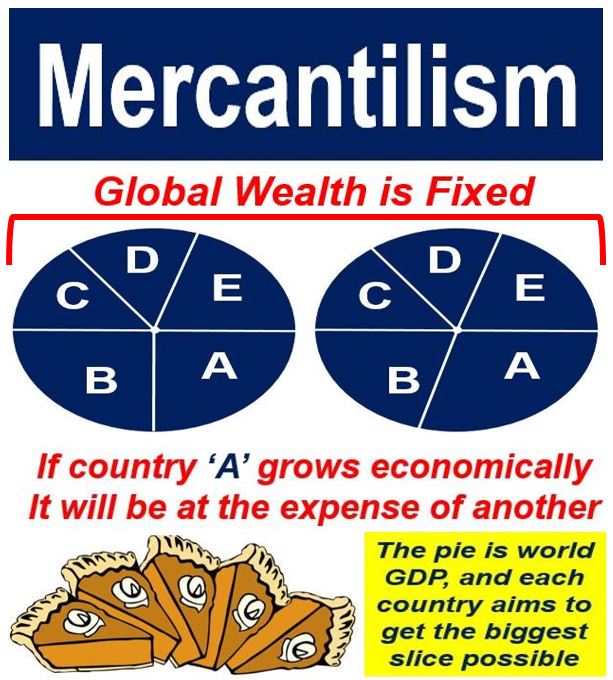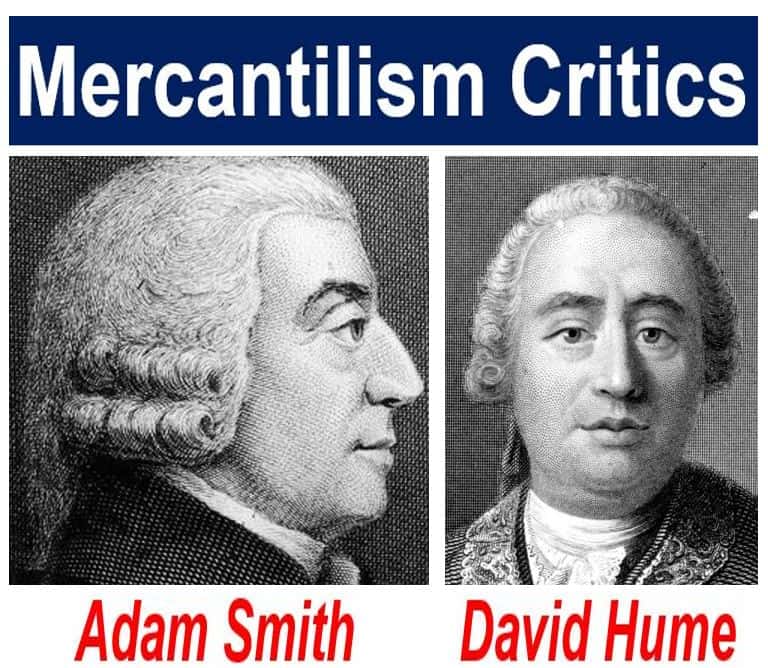Mercantilism was an economic theory that claimed the amount of money in the world was static – fixed – so a country had to make sure its exports were much greater than its imports.
The government-imposed tariffs on imported goods, tried to gain colonies, and accumulated as much wealth and gold as possible. This preference for protectionism and colonialism – that one nation’s gain was another’s loss – was popular in Western Europe from the sixteenth to mid-nineteenth century.
It was an economic system in which the government had control over foreign trade.
Mercantilism’s aim was to ensure the country produced a vast range of products – and lots of them – so that dependence upon foreign suppliers was minimized. A critical element of mercantilism was economic autarky. Autarky is a belief that a nation should become self-sufficient and not import or export.

Mercantilism – cheap money and colonies
Supporters of mercantilism favored cheap money – low interest rates – otherwise money would become too scarce to sustain rapid levels of economic growth and employment.
One of the key aims of mercantilism was to colonize regions beyond the European power centers. This, mercantilists believed, was crucial as a means of expanding volumes of commerce and instituting gold and silver based monetary systems.
Mercantilism was the cause of several wars and battles regarding territory. Each country’s objective was to finance a superior armed force, for both colonial expansion and defense.
For the European colonial powers, the mercantilist period was one of rapid economic growth, especially for the United Kingdom.

Accomplishing mercantilism
Mercantilists said their aims could be primarily accomplished by:
- Import Tariffs: placing high taxes on imported finished goods and very low or no taxes on imported raw materials.
- Export Tariffs: imposing low or no taxes on exported finished goods, and high taxes on exported raw materials.
- Markets: seeking new markets for goods produced at home. In this way demand for goods made at home could be artificially increased.
By following these policies, economies attained trade surpluses, which resulted in the accumulation of gold, silver and other precious metals – which was how accounts were balanced. A necessary by-product of a trade surplus was the accumulation of precious metals and monetary reserves – but not the end goal of mercantilists.
Other common policies included:
- Banning trade between colonial countries and other nations.
- Forbidding the export of precious metals – gold and silver – even for payments.
- Limiting domestic consumption through non-tariff barriers to trade.
- Not allowing international traded goods to be transported in foreign ships.
- Promoting industry and manufacturing through direct subsidies and/or research.
- Using staple ports to monopolize markets. Staple ports were ports designated by a government as a place where certain goods could be exported or imported.
The ultimate goal was to increase domestic production and reduce unemployment.

The birth of anti-mercantilism
The founding fathers of anti-mercantilism were:
– Adam Smith (1723-1790), a Scottish political economist and moral philosopher, a key figure in the Scottish Enlightenment, known today as the ‘father of modern economics’.
– David Hume, a Scottish philosopher and economist, as well as historian and essayist, best known today for his influential system of radical philosophical skepticism, naturalism and empiricism.
Several academics had found major flaws with mercantilism long before Smith developed an ideology that could serve as an alternative.
Critics like John Locke (1632-1704), an English physician and philosopher, known today as the ‘father of Liberalism’, Dudley North (1641-1691), an English merchant, economist and politician, and Hume contributed to the downfall of mercantilism, which progressively lost favor during the 18th century.
Locke argued in 1690 that prices fluctuate according to how much money is in circulation. He also stated in his Second Treatise that the world’s wealth is not static – it is created by human labor.
Hume pointed out how the mercantilists’ goal of a constant positive balance of trade was doomed and unsustainable.
As gold and silver flowed into one nation, the supply there would increase, resulting in the value of the precious metals declining relative to other goods.
Conversely, in the country exporting gold and silver, the value of the precious metals would rise. A point would eventually be reached when it was no longer cost-effective to export goods from the high-price nation to the low-price one, and the balance of trade would start moving in the opposite direction.
By arguing that an increase in the money supply simply meant the every citizen would get richer, the mercantilists were clearly unaware of this flaw.
A viable replacement of mercantilism did not emerge until Smith published An Inquiry into the Nature and Causes of the Wealth of Nations in 1776. His book has the foundations of what we call today Classical Economics. Smith’s book contained many criticisms of mercantilists’ arguments.
From mercantilism to free trade
In Great Britain, mercantilist regulations gradually disappeared during the 18th century. In the 19th century, the British government fully embraced free trade and Smith’s free-market, laissez-faire economics.
In France, mercantilism prevailed until the French Revolution (1789-1799), while in Germany it remained an important ideology throughout the 19th century and the beginning of the 20th century.
Smith said that mercantilists were wrong to focus on production. He argued that paramount to production was consumption. He claimed that merchants liked mercantilism because it was what we call today ‘rent-seeking’ – manipulating economic conditions or public policy as a strategy for increasing profits.
John Maynard Keynes (1883-1946), a British economist whose ideas fundamentally changed the theory and practice of macroeconomics, argued that encouraging both production and consumption was important – he favored a ‘new mercantilism’.
Keynes felt that the mercantilists’ focus on bullion was reasonable. It was one of the few pre-paper money ways to increase the money supply, he said.
Video – What is Mercantilism?
This video, from our YouTube partner channel – Marketing Business Network, explains what ‘Merchandising’ means using simple and easy-to-understand language and examples.
